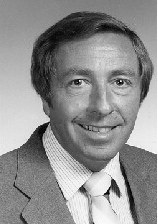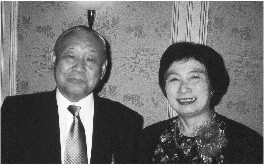

Dr. William G. Duff
Associate Editor

Mr. and Mrs. Takeo Yoshino are shown
during the reception held in May to
celebrate EMC '99 Tokyo.
Our personality profile travels to Japan, to present the fascinating life and career of Professor Takeo Yoshino. Professor Yoshino is a descendent of a local feudal lord of 1250 AD, whose land contains the ruins of a castle, along with a town which carries his family name in the Nara prefecture of Japan. His great-grandfather was the last feudal lord of scholarship of Tokugawa Shogunate, while his grandfather was the vice speaker of the first House of Representatives of Japan. His wife is a professor of literature at Sanno University. His son holds a Ph.D. in geology and a daughter (Master’s degree in electrical engineering) is involved in the development of low-noise microwave and optics circuits at NEC.
Professor Takeo Yoshino received his B.E degree in 1953 from the University of Electro-Communications (U.E.C.), Tokyo, Japan, and joined the Department of Electronic Engineering upon graduation. In 1973, he became department head for graduate students. He retired from UEC in 1995 to teach at the graduate school Fukui University of Technology. In 1970, he worked concurrently as the Director of the Sugadaira Space Radio Observatory which is owned by U.E.C. He has performed research at the Institute of Space and Aeronautic Science (ISAS), National Institute of Polar Research (NIPR) and the Nobeyama Radio Observatory of the National Astronomical Agency.
From 1958 to 1960, he worked at the Syowa Station in Antarctica during the winter as a member of the third Japanese Antarctic Research Expedition. From 1975 to 1977, he was at Syowa Station again, this time as the leader of the 17th Expedition. In Antarctica, his main field of work involved the analysis and investigation of the auroral phenomena related to the natural VLF radio wave emissions observed by people, rockets and satellites.
His research interests include:
1. The investigation on both the emission mechanisms of electrostatic ion-cyclotron waves related to VLF aurora hiss by satellite observations.
2. Observation and study of earthquakes and volcano eruptions by means of seismographic emissions.
3. The phenomena and bio-effects of radio emission phenomena related to VDT and electromagnetic fields.
4. The observation and development of burst VLBI system in the millimeter band associated with radio astronomy.
Professor Yoshino received the IEEE- Antenna and Propagation’s Best Paper Award in 1967, and the Distinguished Service Award at the 1992 EMC Symposium in Wroclaw, Poland. Professor Yoshino is a member of IEIEC, SGEPSS and ASJ (Japan), IEEE and AGU (USA), URSI, IAGA and COSPAR, and is an advisory board member of the Zurich EMC Symposium, Wroclaw EMC Symposium, and Lowell Observatory. He is currently a member of IEEE-EMC Society Board of Directors. From 1990 to 1994, he was chairman of the IEEE EMC-S Tokyo Chapter.
His favorite hobby and pastime is amateur radio. He received his license for the beginner class two months before Pearl Harbor. He could not receive his call sign until after World War II. He was fortunate to receive a National NC-200 receiver one-month before the arrival of the last commercial ship from the U.S.A., prior to the war. The receiver is still operational. After the war, in 1958, he became active as JA1XF, where he continues to frequent the airwaves. His interest in amateur radio has been extended to the collection of both old and new equipment, representing models used from every decade until now.
Currently, Professor Yoshino owns 47 amateur radios produced between 1931 to today. The oldest is a National SW-3 regenerative 1-V-1 receiver built in 1932. He also owns one of the first super-heterodyne receiver produced National FB-7 in 1933. This radio was made only one year after the super heterodyne circuit was developed by Armstrong in 1932. He personally restored all of the equipment in his collection to its original condition.
The most activity related to amateur radio was from the Antarctic during expeditions in 1959 and 1976 with the call of 8J1RL. His “radio shack”, part of his traditional Japanese style home, is one of the most amazing and heart-stopping experiences for amateur radio operators! Many visitors and government officials have visited his home. It was also featured in an article in the American Radio Relay League’s (ARRL) QST magazine.
Professor Yoshino was introduced to EMC in Antarctica during his 1959 visit while studying the violent nature of noise in the polar region. This branched into the study of interference and crosstalk between circuits used within rockets and satellites used for space science research. Included in his field of EMC work is an interest in the bio-effect phenomena related to the measurement of electromagnetic field conditions around mobile transmitting antennas, including amateur radio equipment. His research resulted in the development of a standard for CRT makers to reduce electrostatic field intensity emitted.
In 1980, he discovered phenomena related to ELF, VLF and MF background noise that is observed prior to an earthquake, with the assistance of a Russian scientist. This published work is used by scientists and engineers around the world for predicting when an earthquake is anticipated to occur.
He area of specialty is being a researcher in Geo- and Space Physics for the Institute of Space and Aeronautics Science (ISAS), Japan’s equivalence of NASA. He assisted with the first launching of small rockets in 1953, which began Japan’s space program. He performs research on the emission mechanism of natural electromagnetic waves, launching 22 observation rockets from various countries around the world, including Antarctica. These satellites studied the VLF natural electromagnetic phenomena in space. His greatest discovery was the electrostatic mode wave along the Aurora oval area in the polar upper atmospheric region.
Additional work included the construction of the Nobeyama radio observatory for deep space research of radio waves. This 45-meter dish is currently the world’s largest dish for research in the millimeter band. Discoveries include several pulsar stars and a black hole in the galaxy of our galaxy, plus radio emissions after the great crash of the Shoemaker Levy comets into Jupiter in 1994. Another major design accomplishment was the Hydrogen Maser nuclear standard time generator used for millimeter networks. The short-term accuracy (within several hours) of this oscillator is 10-14, much greater than the Cesium system used by NIST (10-12).
Professor Yoshino continues to live a very active life at the age of 70, with no slowing down on research and educational activities, including being an avid fan of skiing and mountain climbing.